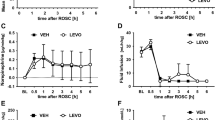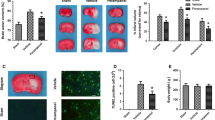Abstract
Background
Stroke is the third leading cause of death in most developed countries. Therefore, a need exists for its treatment. Considering the role that is played by bradykinin in pathogenesis of neuronal injury, it has been suggested that bradykinin antagonists may be useful in the treatment of neurological patients. As noscapine can act as an antagonist of bradykinin and can effectively reduce brain injury after hypoxic-ischemic insult in neonatal rats, the present work was carried out to investigate its effectiveness in a clinical setting.
Methods
Noscapine was administrated orally to ten acute ischemic stroke patients, and the degree of brain injury was evaluated by computed tomography scan and clinical observation. The control group (n=10) did not receive noscapine treatment.
Results
Our study showed that noscapine effectively improved clinical prognosis and reduced the mortality rate down to 20% compared with 80% in the control group. Our patients did not show any specific side effects due to noscapine.
Conclusion
It is concluded that oral noscapine can be an effective drug for reducing the mortality rate in stroke; however, further study with a larger number of patients is needed to determine its full potential in stroke.
Similar content being viewed by others
References
Aramori I, Zenkoh J, Morikawa N, Asano M, Hautori C, Sawai H, Kayakiri H, Satoh S, Inoue T, Abe Y, Sawada Y, Mizutani T, Inamura N, Nakahara K, Kojo H, Oku T, Notsu Y (1997) Nonpeptide mimic of bradykinin with long-acting properties at the bradykinin B2 receptor. Mol Pharmacol 52:16–20
Asano M, Hatori CH, Inamora N, Sawai H, Hirosumi J, Fujiwara T, Nakahara K (1997) Effect of a nonpeptide bradikinin B2 receptor antagonist, FR167344, on different in vivo animal models of inflammation. Br J Pharmacol 122:1436–1440
Bonita R (1992) Epidemiology of stroke. Lancet 339:342–344
Bonita R, Beaglehole R (1988) Recovery of motor function after stroke. Stroke 19:1497–1500
Brott T, Bogousslavsky J (2000) Treatment of acute ischemic stroke. N Engl J Med 343:710–722
Chiu D, Krieger D, Villar-Cordova C, Kasner S, Morgenstern LB, Bratina PRN, Yatsu FM, Grotta JC (1998) Intravenous tissue plasminogen activator for acute ischemic stroke. Stroke 29:18–22
Ebrahimi SA, Zareie MR, Rostami P, Mahmoudian M (2003) Interaction of noscapine with the bradykinin mediation of the cough response Acta Physiologica Hungarica 90:147–155
Francel CP (1992) Bradykinin and neuronal injury. J Neurotrauma 9[Suppl 1]:827–845
Karlsoon MO, Dahlstrom B, Eckernas SA, Johansson M, Tufvesson AA Pharmacokinetics of oral noscapine. Eur J Clin Pharmacol 39:275–279
Ke Y, Ye K, Grossniklaus HE, Archer DR, Joshi HC, Kappa JA (2000) Noscapine inhibits tumor growth with little toxicity to normal tissues or inhibition of immune responses. Cancer Immunol Immunother 49:217–25
Loewen SC, Anderson BA (1990) Predictors of stroke outcome using objective measurement scales. Stroke 21:78–81
Mahmoudian M, Mojaverian N (2001) Effects of noscapine, the antitussive opioid alkaloid, on bradykinin-induced smooth muscle contraction in the isolated ileum of the guinea pig. Acta Physiologica Hungarica. 88:231–237
Mahmoudian M, Siadatpour Z, Ziai SA, Mehrpour M, Benaissa F, Nobakht M (2003) Reduction of the prenatal hypoxic-ischemic brain edema with noscapine. Acta Physiologica Hungarica (in press)
Martindale (1996) The extra pharmacopeia, 21st edn. Reynold, JEF (ed) The Pharmaceutical Press, London, pp 1072–1073
Palmer CH, Vannucci RC, Towfighi J (1990) Reduction of perinatal hypoxic-ischemic brain damage with allopurinol. Pediatr Res 27:332–336
Relton JK, Beckey VE, Hanson WL, Whalley ET (1997) CP-0597, a selective bradykinin B2 receptor antagonist, inhibits brain injury in a rat model of reversible middle cerebral artery occlusion. Stroke 28:1430–1436
Rice JE III, Vannucci RC, Brierley JB, The influence of immaturity on hypoxic-ischemic brain damage in the rat. Ann Neurol 9:131–141
Zausinger SD, Lumenta DB, Pruneau D, Schmid-Elsaesser R, Plesnila N, Baethmann A (2002) Effect of LF16–0687 Ms, a bradykinin B2 receptor antagonist, on brain edema formation and tissue damage in a rat model of temporary focal cerebral ischemia. Brain Res 950:268–278
Acknowledgements
The authors would like to thank Dr. S.A. Ebrahimi for his help and Mrs. F. Yazdani for her encouragement during the course of this study.
Author information
Authors and Affiliations
Corresponding author
Rights and permissions
About this article
Cite this article
Mahmoudian, M., Mehrpour, M., Benaissa, F. et al. A preliminary report on the application of noscapine in the treatment of stroke. Eur J Clin Pharmacol 59, 579–581 (2003). https://doi.org/10.1007/s00228-003-0676-1
Received:
Accepted:
Published:
Issue Date:
DOI: https://doi.org/10.1007/s00228-003-0676-1




